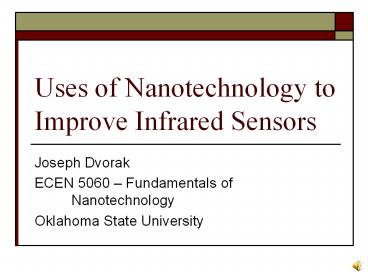Uses of Nanotechnology to Improve Infrared Sensors - PowerPoint PPT Presentation
1 / 12
Title:
Uses of Nanotechnology to Improve Infrared Sensors
Description:
High-sensitivity uncooled microcantilever infrared imaging arrays, edited by F. ... Infrared microbolometer sensors and their application in automotive safety. ... – PowerPoint PPT presentation
Number of Views:134
Avg rating:3.0/5.0
Title: Uses of Nanotechnology to Improve Infrared Sensors
1
Uses of Nanotechnology to Improve Infrared Sensors
- Joseph Dvorak
- ECEN 5060 Fundamentals of Nanotechnology
- Oklahoma State University
2
Introduction
- Current state of infrared technologies
- Quick overview of infrared theory
- Nanotechnologys contributions to improve
infrared sensors - The future of infrared sensors and nanotechnology
3
Infrared Overview
- Infrared radiation is the region of the
electromagnetic spectrum from 720nm to 1000µm and
includes the radiation naturally emitted by
objects at room temperature. - It has long been used by the military, although
recently commercial and industrial uses have
begun to appear. - Main limitations are the necessary trade-offs
between - cost
- bulky and complex equipment
- response time
- image quality
- sensitivity
4
Infrared Theory
- Plancks Law
- Electrical resistance dependent on Temperature
- Thermal Expansion
- Photon Capture
5
Solutions from Nanotechnology
- Thermal Approaches
- Microbolometers
- Microcantilevers
- Quantum Approaches
- Quantum Dots
- Carbon Nanotube-Based Devices
6
Microbolometers
- Infrared Radiation causes a temperature change in
the suspended plate which changes its electrical
resistance. - Essentially a larger scale object that after
undergoing many size reductions is in the
nanoscale. - To maintain thermal isolation of the plate, the
sensor must be packaged in a vacuum and
maintained at that vacuum.
- One of the most advanced infrared detectors to
use nanotechnology as they are already on the
market. - In the future, feature size reductions are
expected.
7
Microcantilevers
- A thermal infrared detector that utilizes
different rate of expansion for different
materials - Device is measured in micrometers, but feature
sizes are in the nanometer range - Currently under development
8
Quantum Dots
- A photon counting method of detecting infrared
radiation - The quantum dots are generally measured in the
single digit nanometers
- Quantum dots are small enough that size begins to
dictate electrical properties - Can trap an electron in three dimensions to
improve sensitivity - Much current work is focused on quantum dots in a
quantum well
9
Carbon Nanotube-Based Devices
- Photon detection method for sensing infrared
radiation that utilizes carbon nanotubes - Since the characteristics of carbon nanotubes can
change with diameter and angle of carbon atom
pattern, picking certain values makes the carbon
nanotube sensitive to infrared radiation - The size of a carbon nanotube, only allows the
electron to travel in one dimension making carbon
nanotubes very useful for implementing across
contacts
- Still in the very early stages of development
10
Future Possibilities
- Low cost, room temperature, simple infrared
detectors based on nanotechnology will find many
uses - Automotive Safety and Control
- Industrial and Construction safety
- Industrial Process Control
- Security Systems
11
Conclusion
- The widespread adoption of infrared systems will
require several improvements - Two primary methods exist to detect infrared
radiation - Nanotechnology has the potential to improve
infrared technologies in several ways, including
the four mentioned here - Solving these challenges in infrared sensing
systems can result in applications that will
greatly improve peoples lives and/or safety
12
Image References
- Hunter, Scott R., Gregory Maurer, Lijun Jiang,
and Gregory Simelgor. 2006. High-sensitivity
uncooled microcantilever infrared imaging arrays,
edited by F. A. Bjorn, F. F. Gabor and R. N.
Paul SPIE. - Krishna, Sanjay. 2005. InAs/InGaAs quantum
dots-in-a-well photodetectors. 5957. Infrared
Photoelectronics. Warsaw, Poland - Yon, J J, L Biancardini, E Mottin, J L Tissot,
and L Letellier. 2003. Infrared microbolometer
sensors and their application in automotive
safety. 7th International Conference on Advanced
Microsystems for Automotive Applications, May 23,
2003. Berlin. - Zhang, Jiangbo, Ning Xi, Hoyin Chan, and
Guangyong Li. 2006. Single carbon nanotube based
infrared sensor. 6395. Electro-Optical and
Infrared Systems Technology and Applications
III. Stockholm, Sweden. - Other references for the topics listed here are
included in the associated paper to this
presentation. They have been omitted here to
save space.































